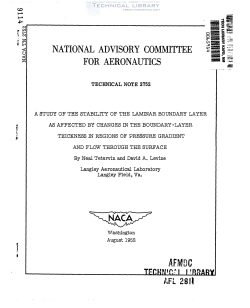naca-tn-2752
- Version
- 100 Downloads
- 2.10 MB File Size
- 1 File Count
- December 16, 2016 Create Date
- December 16, 2016 Last Updated
National Advisory Committee for Aeronautics, Technical Notes - A Study of the Stability of the Laminar Boundary Layer as Affected by Changes in the Boundary Layer Thickness in Regions of Pressure Gradient and Flow Through the Surface

The Schlichting method for the computation of the laminar boundary
layer states that on an impervious surface the shape of the velocity pro—
file is determined by the local effective pressure gradient; this gra-
dient is directly proportional to the product of the actual pressure gra-
dient and the square of the boundary—layer thickness. It is apparent,
therefore, that in a region of falling pressure the Schlichting method
predicts that an increase in boundary-layer thickness increases the
effective pressure gradient and thus results in a more convex velocity
profile. Because the increase in convexity is known to imply an increase
in the critical boundary-layer Reynolds number, it would appear that an
increase in boundary-layer thickness could increase the local critical
Reynolds number more than the local boundary-layer Reynolds number.
In order to investigate this possibility, computations have been
made by combining the Schlichting method with the Lin method for the
calculation of the critical Reynolds number of a velocity profile. The
computations indicate that in a region of falling pressure on an imper-
vious surface an increase in boundary—layer thickness can cause the
velocity profile shape to be changed enough by the increase in effective
pressure gradient so that the ratio of the local critical Reynolds num—
ber to the local boundary-layer Reynolds number is increased. It thus
appears that the local stability of the boundary layer can be increased
by a local increase in boundary-layer thickness. The computations also
indicate that similar effects occur when there is flow through the sur—
face; in this case the results depend on the effective flow through the
surface as well as on the effective pressure gradient.
These calculations suggest that an increase in boundary-layer thick-
ness can decrease the disturbing effect of roughness particles without a'm
decrease in stability. This conclusion is implied by the result that an
increase in boundary-layer thickness reduces the velocity at a fixed
distance from the surface more than the change in velocity profile
increases the velocity. One method of increasing the boundary-layer
thickness, namely, blowing near the stagnation point, has been investi-
gated theoretically and seems to have limited potentialities because the
blowing produces a significant increase in boundary-layer thickness only
over the foremost portion of the airfoil.
| File | Action |
|---|---|
| naca-tn-2752 A Study of the Stability of the Laminar Boundary Layer as Affected by Changes in the Boundary Layer Thickness in.pdf | Download |

Comment On This Post